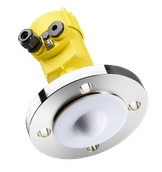Nanothermometer
Tiny gold spheres with a corona of semiconductor nanoparticles show temperature-dependent glow
Advertisement
Small, smaller, nano-nanoscopic particles that can be arranged into controlled superstructures are the stuff from which future "intelligent" materials with new functions could be made. American researchers at the University of Michigan and Ohio University have now developed a "nanothermometer" based on a system made of two different types of nanoparticle.
The thermometer looks like this: the central components of the superstructure are tiny (20 nm) round gold nanoparticles. The research team headed by Nicholas A. Kotov then attached many tinier spheres (3.7 nm diameter) of the semiconducting material cadmium telluride on the surface of these particles by means of molecular "springs" made of polyethylene glycol chains to form a kind of corona around the gold core. When these nanoparticles are irradiated with laser light, the cadmium telluride is induced to glow. The light transfers its energy to an electron-hole pair in the semiconductor acting as a special oscillator, with the electron being in the conduction band and the hole in the valence band. The electron-hole energy packet is called an exciton. When an electron and a hole are reunited, the energy is released as luminescence and the semiconductor particle glows.
In contrast, as a metal the gold nanoparticle has freely moving conduction electrons that surround the crystal lattice in an "electron cloud". The presence of an external electromagnetic field, for instance from an exciton, can induce this cloud to vibrate. This vibrational energy packet is called a plasmon. The gold/cadmium telluride nanoparticle system was tuned so that the energies of the corona excitons and the core plasmons are very close.When this is the case, the excitons and plasmons can interact (resonance): the luminescence of the corona is increased significantly. The size of this effect depends on the distance between the coronal particles and the central gold particle, that is, the length of the spring, which is, in turn, temperature-dependent. When heated from 20 to 60 °C, the springs stretch out, the distance between the core and the corona increases, and the glow decreases. If the particles are cooled again, the springs contract, the corona moves closer to the core, and the glow gets brighter. "Our nanoparticle system is an example of a nanoscopic superstructure that changes reversibly in response to an external stimulus, in this case, temperature," says Kotov. "The coupling with a plasmon-exciton interaction makes this response visible as a very sensitive optical signal-a principle that could form the basis for a new family of sensors and optoelectronic components."
Original publication: N. A. Kotov; "Nanoparticle Assemblies with Molecular Springs: A Nanoscale Thermometer"; Angewandte Chemie International Edition 2005.
Other news from the department science
These products might interest you
Most read news
More news from our other portals
See the theme worlds for related content
Topic world Sensor technology
Sensor technology has revolutionized the chemical industry by providing accurate, timely and reliable data across a wide range of processes. From monitoring critical parameters in production lines to early detection of potential malfunctions or hazards, sensors are the silent sentinels that ensure quality, efficiency and safety.

Topic world Sensor technology
Sensor technology has revolutionized the chemical industry by providing accurate, timely and reliable data across a wide range of processes. From monitoring critical parameters in production lines to early detection of potential malfunctions or hazards, sensors are the silent sentinels that ensure quality, efficiency and safety.
































































